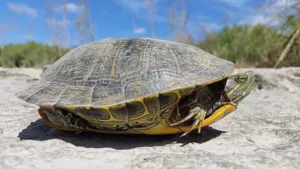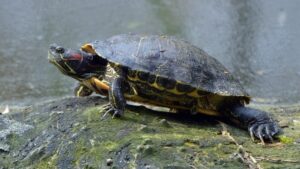Curious about the aquatic endurance of red-eared sliders? Join us as we dive into the fascinating world of these charming reptiles to uncover the answer to the intriguing question: How long can a red-eared slider hold its breath?”
Red-eared sliders, like many aquatic turtles, are remarkable breath-holders. On average, they can hold their breath for about 15 to 30 minutes. However, this duration can vary depending on factors such as age, size, health, and activity level.
In some cases, they may even remain submerged for longer periods, especially when they are in a state of hibernation or torpor during colder months.
How long can a red eared slider hold its breath?

Red-eared sliders, being aquatic turtles, have evolved various adaptations to thrive in water environments. One such adaptation is their ability to hold their breath for extended periods. When a red-eared slider submerges itself underwater, several physiological mechanisms come into play to enable it to remain submerged:
- Slow Metabolism: Red-eared sliders have a relatively slow metabolic rate compared to many other animals. This means that they don’t consume oxygen as quickly, allowing them to sustain themselves with less frequent breaths.
- Oxygen Absorption from Water: While underwater, red-eared sliders can absorb oxygen directly from the water through specialized membranes in their cloaca, which is the opening used for excretion and reproduction. This adaptation allows them to extract oxygen from the surrounding water, supplementing what they obtain from breathing air.
- Efficient Lung Structure: Although they are primarily aquatic, red-eared sliders still have lungs. Their lungs are adapted to facilitate efficient gas exchange, allowing them to extract as much oxygen as possible from each breath.
- Behavioral Adaptations: Red-eared sliders are capable of slowing down their heart rate and reducing their activity level while underwater, conserving oxygen and extending the duration they can hold their breath.
The exact duration a red-eared slider can hold its breath varies based on factors such as age, size, health, and activity level. Younger turtles and those that are more active typically have higher metabolic rates and may need to surface for air more frequently than older, less active turtles.
On average, a red-eared slider can hold its breath for anywhere from 15 to 45 minutes, but individual turtles may exceed these times under certain conditions. It’s essential to provide these turtles with appropriate access to both water and dry land in their habitat to ensure they can regulate their oxygen intake effectively.
Factors influencing their ability to hold their breath
Several factors influence a red-eared slider’s ability to hold its breath underwater:
- Age and Size: Younger turtles tend to have higher metabolic rates and may need to surface for air more frequently than older turtles. Similarly, smaller turtles have smaller lung capacities and may need to surface more often than larger ones.
- Activity Level: Turtles that are more active, such as those swimming or foraging, may consume oxygen more quickly and need to surface for air sooner than those that are resting or inactive.
- Health: Health plays a significant role in a red-eared slider’s ability to hold its breath. Illness or injury can impact their respiratory system, making it more difficult for them to hold their breath for extended periods.
- Environmental Conditions: Water temperature and quality can affect a red-eared slider’s metabolism and oxygen requirements. Warmer water temperatures generally increase metabolic rates, while poor water quality can stress the turtle and affect its ability to respire effectively.
- Habitat Design: The design of the turtle’s habitat can influence its ability to hold its breath. Access to both water and dry land allows the turtle to regulate its oxygen intake effectively. Adequate basking areas are essential for red-eared sliders, as exposure to heat and UV light helps maintain their overall health and metabolic function.
- Species-specific Adaptations: Red-eared sliders, like other aquatic turtles, have evolved physiological adaptations to facilitate underwater respiration, such as the ability to absorb oxygen through their cloaca and efficient lung structures.
By considering these factors and providing appropriate care and habitat conditions, turtle owners can help ensure their red-eared sliders can comfortably regulate their oxygen intake and thrive in their environment.
Understanding Breath-Holding in Red Eared Sliders

Understanding breath-holding in red-eared sliders involves delving into their unique biology and behavior:
- Physiological Adaptations: Red-eared sliders possess physiological adaptations that enable them to hold their breath underwater. These adaptations include a slow metabolic rate, efficient lung structures for gas exchange, and the ability to absorb oxygen through specialized membranes in their cloaca.
- Oxygen Requirements: While underwater, red-eared sliders primarily rely on stored oxygen and the oxygen they absorb from the water. Their metabolic rate determines how quickly they consume oxygen, influencing how long they can hold their breath before needing to resurface for air.
- Behavioral Responses: Red-eared sliders exhibit behavioral responses to optimize their oxygen intake while submerged. They may slow down their heart rate and reduce their activity level, conserving oxygen and extending the duration they can stay underwater.
- Environmental Factors: Environmental factors such as water temperature, quality, and habitat design also influence a red-eared slider’s ability to hold its breath. Warmer water temperatures generally increase metabolic rates, while poor water quality or inadequate habitat conditions can stress the turtle, affecting its respiratory function.
- Individual Variation: Like all animals, individual red-eared sliders may vary in their ability to hold their breath. Factors such as age, size, health, and genetics can contribute to these variations.
By considering these factors, researchers and turtle enthusiasts can gain a deeper understanding of how red-eared sliders manage their breath-holding abilities and adapt to their aquatic environment. This knowledge is crucial for providing appropriate care and habitat conditions to ensure the health and well-being of these fascinating reptiles.
How to ensure a suitable environment for Red Eared Sliders
Creating a suitable environment for red-eared sliders involves addressing their specific needs for both water and land areas. Here are some key considerations:
- Aquatic Habitat:
- Size: Provide a spacious aquatic area that allows for swimming and diving. A general rule of thumb is to offer at least 10 gallons of water per inch of shell length for juvenile turtles, increasing to 20 gallons per inch for adults.
- Water Depth: Ensure the water is deep enough for the turtle to fully submerge but shallow enough for it to easily reach the surface for air. The depth should be at least twice the turtle’s shell length.
- Filtration: Install a high-quality filtration system to maintain water quality. Canister filters or aquarium power filters are suitable options.
- Water Heater: Maintain the water temperature between 75-80°F (24-27°C) using a submersible aquarium heater to mimic their natural habitat.
- Basking Area: Provide a dry, elevated basking area where the turtle can completely leave the water to regulate its body temperature and dry off. Use materials such as rocks, driftwood, or commercial basking platforms.
- Land Area:
- Size and Accessibility: Ensure the basking area is large enough for the turtle to comfortably climb onto and move around. It should be easily accessible from the water.
- Heat Lamp: Install a heat lamp above the basking area to provide a basking spot temperature of 85-90°F (29-32°C). Use a UVB lamp to provide essential UVB radiation for shell and bone health.
- Substrate: Choose a substrate for the land area that is easy to clean and won’t cause impaction if ingested. Options include smooth river rocks, large gravel, or reptile-safe substrate.
- Environmental Enrichment:
- Plants: Add live or artificial aquatic plants for cover and enrichment. Ensure any live plants are non-toxic and can withstand being partially submerged.
- Hiding Spots: Provide hiding spots both underwater and on the basking area to reduce stress and encourage natural behaviors.
- Toys and Accessories: Offer floating toys, ramps, or platforms to stimulate activity and exploration.
- Water Quality and Maintenance:
- Regular Cleaning: Perform partial water changes (about 25% of the water volume) every 1-2 weeks to remove waste and maintain water quality.
- Water Testing: Monitor water parameters regularly using test kits to ensure appropriate pH, ammonia, nitrite, and nitrate levels.
- Hygiene: Clean the basking area and any accessories regularly to prevent the buildup of bacteria and algae.
By addressing these aspects of their environment, you can create a comfortable and stimulating habitat for your red-eared slider, promoting their health and well-being in captivity.
Signs of distress or health issues related to breath-holding

Signs of distress or health issues related to breath-holding in red-eared sliders can manifest in various ways. Here are some signs to watch for:
- Gasping for Air: If a red-eared slider appears to be gasping for air at the water’s surface frequently or for extended periods, it could indicate respiratory distress.
- Lethargy: A turtle that is unusually lethargic or inactive, spending excessive time basking or resting at the water’s surface, may be experiencing health issues affecting its ability to regulate its breath-holding.
- Abnormal Behavior: Look out for any changes in behavior, such as decreased appetite, reluctance to swim, or avoidance of the basking area, which could signal underlying health problems.
- Open-Mouth Breathing: Red-eared sliders typically keep their mouths closed when at rest. Open-mouth breathing, especially when not basking, can indicate respiratory distress or other health issues.
- Abnormal Posture: An abnormal posture, such as holding the head or limbs in unusual positions, may indicate discomfort or respiratory distress.
- Excessive Mucus or Discharge: Excessive mucus around the nostrils or in the mouth, or any other abnormal discharge, can be signs of respiratory infection or other health issues.
- Shell Abnormalities: Changes in the appearance or texture of the turtle’s shell, such as soft spots, discoloration, or shell rot, can indicate underlying health problems affecting the respiratory system or overall health.
- Decreased Appetite: A sudden decrease in appetite or refusal to eat can be a sign of various health issues, including respiratory problems.
- Weight Loss: Significant weight loss or emaciation without a clear cause may indicate underlying health issues affecting the turtle’s respiratory and metabolic functions.
If you observe any of these signs in your red-eared slider, it’s essential to seek veterinary attention promptly. A qualified reptile veterinarian can perform a thorough examination, including diagnostic tests if necessary, to determine the underlying cause of the symptoms and recommend appropriate treatment. Early intervention is crucial for addressing health issues effectively and promoting the well-being of your turtle.
Conclusion
You can get the answers to the question how long can a red eared slider hold its breath on this page. Red-eared sliders, with their remarkable adaptations for underwater respiration, can hold their breath for varying durations, typically ranging from 15 to 45 minutes or longer under optimal conditions.
Factors such as age, size, health, and environmental factors influence their breath-holding ability. Understanding these factors is crucial for providing appropriate care and ensuring the well-being of these fascinating aquatic turtles.

